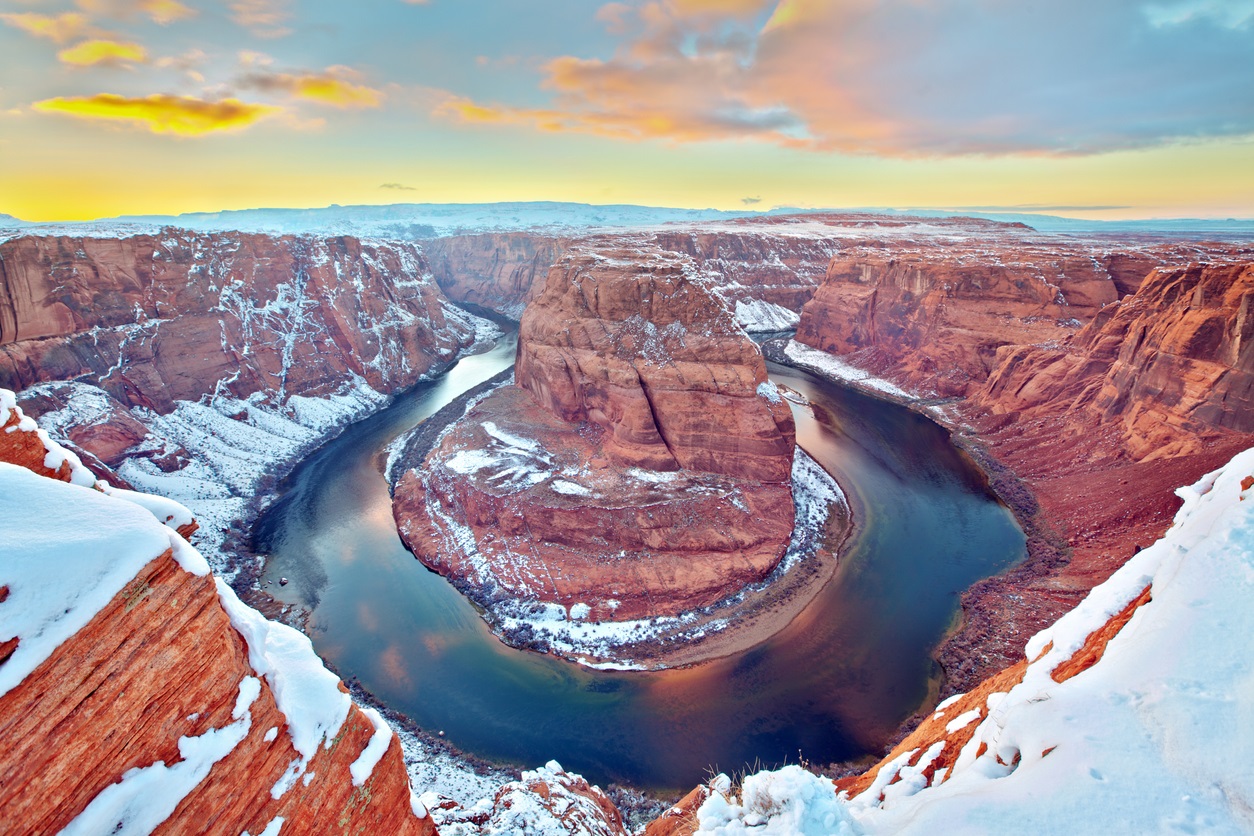“America the Beautiful” with a range of landscapes across spacious skies accurately describes this land “from sea to shining sea” plus non-contiguous states and territories. With a wide array of U.S. national park sites spanning more than 85 million acres, deciding where and when to go can feel overwhelming. While most national parks in the U.S. are wonderful to visit during any season, Winetraveler narrowed down 10 of the best national parks to add to your winter travel list.
You can view current flight deals here and hotel options here for any of the destinations we mention below.
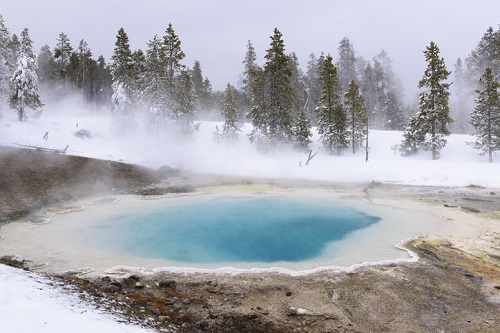
Yellowstone National Park, Wyoming
Yellowstone National Park, largely recognized as being the world’s first national park established in 1872, was the obvious choice to be listed here first. The park is located primarily in the state of Wyoming (~96%) with ~3% extending in Montana, and the remaining ~1% in Idaho. It spans roughly 3,500 square miles. Summer is overwhelmingly the most popular month to visit this park, but it is truly majestic in the winter. While the temperatures are frigid during the winter season, the crowds are minimal, and witnessing the steam rising out of the frozen land from the geysers is pure magic. It looks like the snow is on fire. The numerous hydrothermal and geological areas are wondrous. Wildlife is plentiful. Bison, elk, swans, and bald eagles are commonly seen.
RELATED: Itinerary For Big Sky, Jackson Hole and/or Yellowstone National Park
With most roads in the park being closed from around early November through mid-April, expect to explore the park via snowmobiles, skis, snowshoes, or snowcoach. The National Park Service (NPS) site lists ski and snowshoe trails here. Visiting the popular Old Faithful and/or the Grand Canyon of Yellowstone are reachable by either snowmobile or snowcoach generally from mid-December through mid-March. Old Faithful’s fame is due in large part to its predictable eruptions. Each eruption lasts between 1.5 to 5 minutes and can shoot up between 3,700 to 8,400 gallons of boiling water reaching an average height of ~135 ft. The Grand Canyon of Yellowstone is incredible in the winter. The waterfall that drops 308 ft. is frozen in the distance amid a canyon surrounded by yellow-colored rocks and green pine trees.
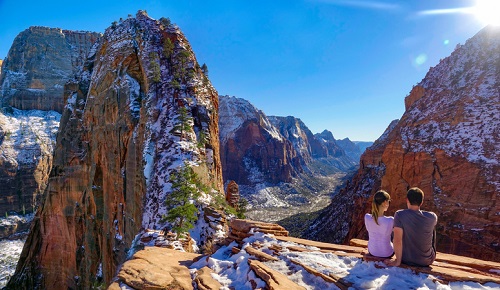
Zion National Park, Utah
As previously covered by Winetraveler, “Zion National Park in southwestern Utah is an other-worldly region, almost mystical. The landscape here is one of the most unique in the world, carved out largely by millions of years of erosion courtesy of the now sporadically flowing Virgin River. Zion sits at substantial elevation, with the lowest point in the canyon resting at 3,666 ft. The highest point in the park is found at Horse Ranch Mountain, which sits at 8,726 ft.”
“Zion National Park is open year-round. Autumn and late spring are some of the best seasons to visit the park as they offer cooler temperatures and beautiful colors. However, they can also be relatively popular seasons.” If you’re a fan of cooler temperatures, avoid the crowd and visit in the winter. Be prepared with layers (with traction aides if there are icy patches) as the weather can be a bit more unpredictable this time of year.
“Zion National Park gets its unique red, orange, pink, white and black rock colors from a variety of minerals. However, it’s the dominant presence of iron that gives the sandstone in the region its signature red and pink hue. . . . There is also an abundance of wildlife and a diverse array of plant species in the area. If you visit, keep your eyes to the sky for eagles, hawks, owls, and dozens of species of bats. On the ground, look for deer grazing along the scenic roads and trails, gray foxes, and at a higher elevation, bighorn sheep.”
Hike, take scenic drives and relish your time here. Popular hikes include Grotto Trail, Weeping Rock Trail, Angel’s Landing via West Rim Trail, Hidden Canyon Trail via East Rim Trail, and the Narrows via Riverside Walk. As of the time of writing this, Hidden Canyon Trail and Weeping Rock Trail are closed due to major rockfall.
RELATED: The Ideal Epic 4-Day Zion National Park Itinerary
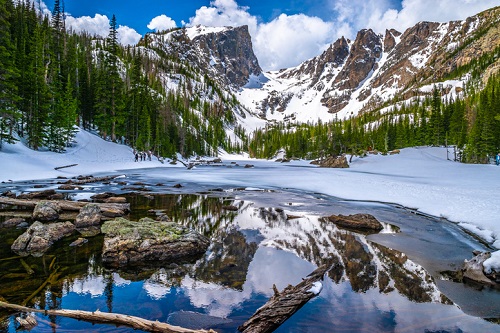
Rocky Mountain National Park, Colorado
The Rocky Mountains are synonymous with “winter wonderland” during the winter season. The spectacular peaks blanketed in pristine snow appear to extend forever. The mountain range stretches ~3,000 miles across New Mexico, Colorado, Utah, Wyoming, Montana, and Idaho, and into Alberta and British Columbia in Canada. The Rocky Mountain National Park, about 66 miles from Denver, Colorado, covers wondrous mountain environments within this range across ~415 square miles.
The park’s towering landscapes and its high elevation make it uniquely majestic. Seventy-seven mountains in the park reach above 12,000 ft. Longs Peak, rising to 14,259 ft., is the highest in the park. Winding rivers and frozen lakes will be discovered throughout the park.
Exciting winter adventures to explore the park include snowshoeing (essentially hiking with snowshoes strapped on your boots), cross-country skiing through snow-covered forests, sledding, and wildlife watching. Moose, deer, elk, and bighorn sheep are a few of the wildlife you may encounter. Bear Lake Corridor Trails (PDF) are popular trails. Since winter is the off-season, you may enjoy the peaceful splendor of exploring trails without others.
The Trail Ridge Road, which is a scenic drive covering 48 miles from Estes Park and Grand Lake, is generally closed in the winter. Save this drive for a warmer season. More than 20% of the highway is above the treeline and peaks at 12,183 ft.
Arches National Park, Utah
Delicate Arch, the iconic image of Utah, is located in Arches National Park. Experience this astonishing natural wonder, along with numerous more natural stone arches and red rock formations, without the crowd and intense heat by visiting in the winter.
Drive around the park and soak in the sights of the red-rock wonderland. With most hiking trails open year-round, select the trails that most interest you. The quintessential trail is the 3-mile roundtrip trail to Delicate Arch is designated as “difficult.” There is no shade, and a considerable amount of the trail is over slick rock. Many plan to make it to Delicate Arch for sunset. If you choose to do this, bring a flashlight or a headlamp as the sun sets quickly, it gets very dark, and the rocks can be slippery. Seeing your foot placement, especially while traversing over a rocky landscape, is important.
Popular trails designated as “easy” include Balanced Rock (0.3 miles), The Windows (1 mile), Double Arch (0.5 miles), wheelchair-accessible viewpoints of Delicate Arch (100 yards to 0.5 miles, neither take you to Delicate Arch), and Landscape Arch (1.9 miles). Review more trails and their descriptions on the NPS’s website here. Many trails are categorized as being accessible to wheelchairs with assistance.
While the colder season is a more peaceful time to explore the park, it can get cold and you may need to allow for more flexibility since the weather can be unpredictable. If there is snowfall, the roads in the park may close to allow for plowing. Dress in layers, as the temperatures range from 0-50 degrees Fahrenheit this time of year. If you’re hiking a trail after snowfall (even a light snowfall), be sure to be wearing shoes with good traction and bring trekking poles as the trails can get slippery.
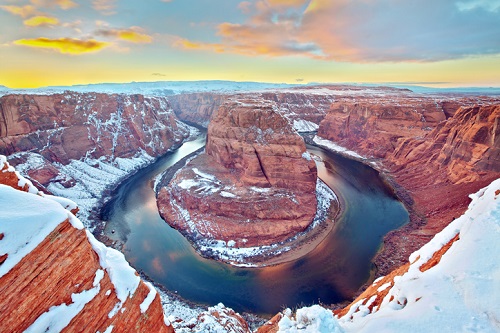
Grand Canyon National Park, Arizona
The feeling many get when first seeing the Grand Canyon is an overwhelming feeling of awe. Plan a winter visit to Grand Canyon National Park to enjoy the abundant beauty without the spring or summer crowds. Depending on the timing of your visit, you may even see the canyon with a coating of snow.
Ride a shuttle to see more of the canyon and stop at the viewpoints to soak in the majesty of the landscapes. While the South Rim remains operational year-round, the North Rim is closed during the colder months (generally from around mid-October through mid-May). Select shorter hikes this time of year as the trails are not maintained in the winter. Stay for sunset and be mesmerized by the change of colors against the rock before retiring back to your lodge.
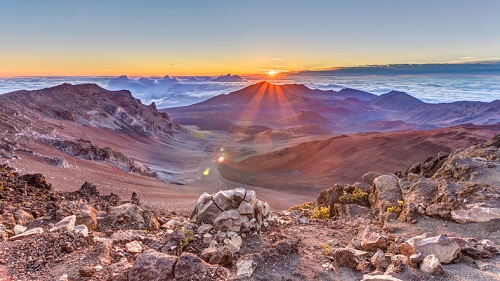
Haleakala National Park, Maui, Hawaii
What better place to escape the cold than a trip to Maui? Take a break from sunbathing and mai tais and head over to Haleakalā National Park, a dormant volcano that forms more than 75% of Maui. It rises 10,023 ft. above sea level, but 19,680 ft. of the mountain is under the ocean. As described by the NPS, “[t]his special place vibrates with stories of ancient and modern Hawaiian culture and protects the bond between the land and its people. . . . [R]enew your spirit amid stark volcanic landscapes and sub-tropical rainforest with an unforgettable hike through the backcountry.”
The crater is 2,600 ft. deep, two miles wide, and nearly 7 miles across. If you’re going for sunrise (as many do), check the times for sunrise and then subtract a buffer. Anticipate strong winds and a significant drop in temperate up at the crater. While it may be bathing suit-weather down by the beach, bring at least a wind jacket on the crater. If you plan to hike in this desert landscape, you will want to be dressed for cooler temperatures.
Return down to hot, humid, and frequently rainy weather and hike Pipiwai Trail to Waimoku Falls, a waterfall that cascades down 400 ft. The path to the waterfall takes you through a dense and enchanting bamboo forest. The tall bamboo trees appear endless.
RELATED: 5 Day Maui Itinerary & Travel Guide: The Best Things To Do
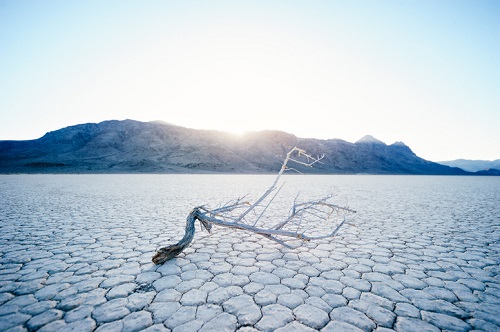
Death Valley National Park, California
Visit Death Valley National Park in the winter to beat the heat. The NPS describes it as the “[h]ottest, driest, and lowest National Park. In this below-sea-level basin, steady drought and record summer heat make Death Valley a land of extremes.” This vast national park covers more than three million acres of wilderness. Explore hiking trails and historic sites, go mountain biking or traverse along the hundreds of backcountry roads. Search popular hiking trails here, such as Mesquite Flat Sand Dunes, Salt Creek Interpretive Trail, Mosaic Canyon Trail, and many others. The park has designated sunrise and sunset spots and designated stargazing spots.
Florida National Parks
Since many winter travelers are looking to escape the cold, for those looking to do just that, South Florida has three national parks. Winter is a great time to visit because there is less rain, fewer mosquitoes, and the heat is less intense than what can be expected during the summer season. This also corresponds to being the busiest time of the year to visit.
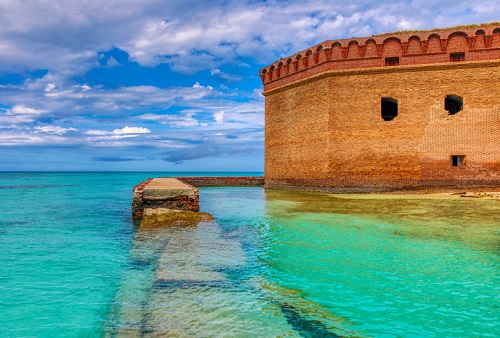
Dry Tortugas National Park, Florida
Dry Tortugas consists of seven small islands located nearly 70 miles off Key West. Accessing the Dry Tortugas National Park, by boat or seaplane, is part of the adventure. Walk through history at Fort Jefferson, a 19th-century fort. With more than 16 million bricks, it’s the Western Hemisphere’s largest brick building. Revel in the tropical climate by sunbathing and snorkeling the clear blue waters to discover the immense beauty of the coral reefs.
Based on the inaccessibility of this park, the limited transportation options, and the restrictions on the number of daily passengers, book your ferry or seaplane charter in advance. You can also select a fishing, diving, snorkeling, or wildlife-viewing authorized tour operator. Here is a list of the NPS’s permitted tour guides. If you head over on your boat, make sure to get a boat permit first.
Winetraveler Tip: Bring food and gear. There are no restaurants, fuel stations, fishing supplies, or other gear available for purchase or rent in the park.
Everglades National Park, Florida
America’s Everglades, described by the NPS as “[t]he largest subtropical wilderness in the United States. Everglades National Park protects an unparalleled landscape that provides important habitat for numerous rare and endangered species like the manatee, American crocodile, and the elusive Florida panther.” This is Florida’s most popular national park, and at ~1.5 million acres of wetland, is Florida’s largest national park.
Based on the size of this park and the distance between its three entrances accessible from Miami (temporarily closed due to flooding), Everglades City, or Homestead, plan ahead where you want to go. Outdoor adventures, such as airboat tours, hiking, canoeing, kayaking, biking, fresh and saltwater fishing (with a license), camping, bird watching, off-trail hiking called slogging, and wildlife viewing while engaged in any of the foregoing are fun ways to explore the park’s diverse habitats.
Shark Valley’s observation tower provides panoramic views. The canoe/kayak trails range from a few hours up to several days. The Nine Mile Pond canoe/kayak trail is popular and accessible from the Flamingo area of the park. There is also a 99-mile-long Wilderness Waterway that can be completed over 7-10 days by canoe/kayak.
Winetraveler Tip: Seeing alligators is nearly as guaranteed as being bitten by mosquitos. Be cautious, keep a careful watch on young children, and bring insect repellent.
Biscayne National Park, Florida
At Biscayne National Park, adventure by day via snorkeling, diving, canoeing, kayaking, boating, or fishing, and then return to the nearby hustle and bustle of downtown Miami at night. The clear waters, mangrove shorelines, emerald islands, and enchanting coral reefs and shipwrecks provide unique water-based outdoorsy activities. Search authorized guided tours here that include snorkeling at the shipwrecks on the Maritime Heritage Trail, cruising to Boca Chita Key, and sailing on Biscayne Bay.
RELATED: Best Miami Wine Bars to Grab a Drink in Different Neighborhoods
These are just ten of many national parks that are great to visit in the winter. Share your favorites in the comments.
